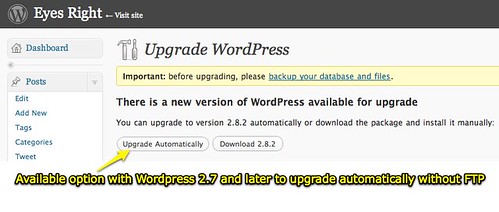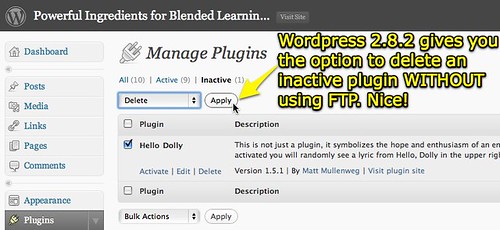If you use a commercially hosted blogging platform like Blogger, EduBlogs, WordPress.com, Squarespace, or Typepad, count your blessings when it comes to upgrade headaches. I do enjoy using and love self-hosted WordPress blogs, but there is a periodic price to pay in time as well as hand-wringing which comes with self-hosting.
Updating / upgrading WordPress blogs is admittedly a more stressful experience for me now because my blogs have become much more important to me over the years, and I now maintain several which are relatively active. (1 – 2 – 3 – 4 – 5) This blog (“Moving at the Speed of Creativity”) is my main “production” blog– In the past when I’ve had upgrade woes with it, it has caused me some SERIOUS stress. I remember one of these episodes several years ago, when my wife didn’t have a good understanding of why my blog (something virtual and “not real”) could cause so much stress. Since we are paying so much more per month for my blog hosting (on a VPS) it’s safe to say her understanding of the importance of my blog has definitely grown/expanded. Still, it does seem kind of weird that something so geeky and detached from the “real world” could cause so much real-world stress if things go awry.
I still keep the WordPress blog “Talking Science” online even though we haven’t posted to it in a couple years, since the site serves as a useful “sand box” from time to time for me to test new WordPress plug-ins. “Learning Signs” has really replaced “Talking Science” as a blog used by my kids, but I do still use the intro and transition audio files on “Talking Science” periodically when I’m teaching about podcasting and Audacity. (Feel free to use those if you want as well, I’m going to keep them up there/available, and they are just basic audio files created with royalty-free loops from Garageband.)
WordPress version 2.8 has been available for several weeks now, but I’ve held off updating because I’ve learned it’s best not to rush the update process. Mistakes can be easy to make, especially when updating via FTP “the old way,” and in the past it has taken me awhile (read several hours) to get errors and problems resolved when I’ve done something wrong. I’ve also held off because Miguel Guhlin alerted me recently that users have reported problems with the visual editor in WP 2.8. I wanted to wait until those bugs were fixed. Since there have been two more releases of WordPress (2.8.1 and 2.8.2) I’m betting those problems have been resolved. 708 tickets have been entered into the WordPress Trac for version 2.8, and it looks like most are resolved. This evening, I am delighted to say I’ve successfully backed up (always a must) and upgraded all the WordPress blogs I maintain to version 2.8.2! This includes migrating my son’s string figure blog (which he hasn’t posted on in awhile, but we still want to keep) from a custom domain (stringandme.com) to a subdomain address. Last summer, I paid $40 to add an “add-on slot” to my account with Siteground, so he could have “his own domain.” This was cool, but really not worth $40 per year, especially since he lost interest in posting new videos to it. As a result, four of the six WordPress blogs I now maintain are on “subdomains” of my primary domain / site:
– eyesright.speedofcreativity.org
– learningsigns.speedofcreativity.org
– stringandme.speedofcreativity.org
– talkingscience.speedofcreativity.org
Only one is an “add-on” site:
– www.powerfulingredients.com
Add-on sites share the disk space and bandwidth of other sites on a hosting account, but can have their own domain name.
I recorded a 4 minute video podcast back in September of 2008 explaining how to configure a subdomain with CPanel. I’m a big fan and user of subdomains, not just for blogging but also for Ning and wiki sites like the ones we use for Celebrate Oklahoma Voices.
Here are a few of my learning points from tonight’s multi-hour WordPress upgrade saga, which is thankfully now over.
Password management for this many blogs and web hosting setups is pretty much a nightmare. I have taken the step of actually using secure and different passwords for all these setups, and I keep those recorded in two different web-based note service sites. This aspect of website maintenance is definitely not fun, but a necessary evil from a security standpoint.
I learned in May the importance of periodically “repairing” mySQL databases used by WordPress using phpMyAdmin. Tonight I learned that repeated “repairs” are sometimes needed to remove all “overhead” from a mySQL database. After 3 repairs, all the “overhead” on this particular mySQL database was deleted.
I don’t completely understand what “overhead” is in a mySQL database, but basically it sounds analogous to disk fragmentation which naturally takes place when you use any hard drive. Periodically “housekeeping” is beneficial from a performance standpoint to remove the “overhead” with a phpMyAdmin “repair” command, similar (but much easier and less time consuming) than the way you defrag a hard drive.
The BEST feature of the latest WordPress versions (starting with 2.7 I think) is that you can now upgrade your WordPress installation right from the web-based dashboard, WITHOUT using a FTP program. This feature ROCKS.
In the past, the WordPress upgrade process was:
1- Disable all WordPress plugins
2- Download the new WordPress files and upload them to your WordPress directory using FTP
3- Execute the command (with a URL) to update your WordPress mySQL database
4- Re-activate all your WordPress plugins.
Now, with version 2.7 and newer, you can simply click the UPGRADE option boxes twice in the dashboard to upgrade your actual WordPress files.
This worked flawlessly for me on all six of my WordPress blogs tonight, and I am DELIGHTED. This is particularly good since I’m staying in a motel with pretty slow upstream bandwidth, so it would have taken MUCH longer to manually upload the latest WordPress files to all six web directories. This is, without a doubt, my favorite feature of the latest WordPress engine. Thank you, WordPress developers, for making this upgrade process MUCH less painful and time consuming!
One of the benefits of upgrading from WordPress 2.7 to 2.8.2 is users can now delete plug-ins directly from the dashboard without using FTP, similar to the way WordPress files can be updated.
This is nice and streamlines plug-in management considerably.
The only plug-in I’m using which I still had to manually update with FTP is “WordPress Mobile Edition” by Crowd Favorite. This is one of my favorite (no pun intended) WordPress plug-ins now, since it shows smartphone users (including iPhones) a streamlined, quick-loading, mobile friendly theme by automatically detecting that a mobile browser is in use. After our vacation last week when I mobile-blogged with WordPress for iPhone and uploaded about 350 photos to Flickr and Facebook using PixelPipe, I’m an even bigger fan of “WordPress Mobile Edition” than before. WP Mobile Edition has two parts, a plug-in file and a theme folder. To install, you have to use FTP to upload the theme folder to wp-content/themes as well as the plug-in file to wp-content/plugins. This isn’t a huge hassle, but I did have to repeat this six times for my six WordPress installation instances. Thankfully, other plugin updates (like Akismet) could be done directly from the browser without FTP. Very nice.
I recently learned about the Postrank for WordPress plugin and started using after seeing Postrank used by Richard Byrne on his fantastic blog, “Free Technology for Teachers.” So far it seems to be working well and not conflicting with all the other WordPress plug-ins I’m using.
My final learning point from this afternoon’s / evening’s WordPress update saga involved moving an existing WordPress site to a new domain. As I mentioned previously, I chose NOT to renew the domain “stringandme.com” for Alexander’s string figure tutorial/video blog, and instead moved it to a subdomain. I had to get Siteground tech support to change the subdomain settings, since the directory I’m using is in my hosting account’s root level and my CPanel wouldn’t let me change it. I thought I would have to make a CNAME entry change for the subdomain as well, but CPANEL actually did that automatically once tech support made the adjustment. What I DID have to do, however, was edit a record entry in phpMyAdmin for the actual blog site’s URL. I had never done this before.
It wasn’t hard to do, but it took some Googling to find a WordPress codex article in which a user shared this step.
Whew! I’m relieved all these upgrades and site changes are finished. Now at some point, I still need to figure out how to re-activate my WordPress error logs on my main blog, and try to evaluate those error logs so I can increase the speed/efficiency of my blogs (especially this one) and reduce the mySQL server processor cycles. That was apparently a big reason Siteground insisted I switch to a VPS several months ago. During that time, I ended up deleting my server error log after downloading it and I don’t think it’s been working since. I think I continue to get a LOT of errors from the PodPress plugin, but because all my podcasts are linked via PodPress I can’t afford (time and troubleshooting-wise) to deactivate it.
I definitely won’t be doing any more WordPress tinkering tonight. 🙂
Technorati Tags:
blog, blogging, wordpress, upgrade, update, 2.8, 2.8.2
If you enjoyed this post and found it useful, subscribe to Wes’ free newsletter. Check out Wes’ video tutorial library, “Playing with Media.” Information about more ways to learn with Dr. Wesley Fryer are available on wesfryer.com/after.
On this day..
- Favorite Videos from iPad Media Camp – 2012
- Brainstorming Conference & PD Session Topics for 2011-2012 – 2011
- We SAW the International Space Station Fly Over Oklahoma City! – 2011
- Full Solar Eclipse Images – 2009
- First experiences with web-based digital story editing: JumpCut! – 2008
- links for 2008-07-22 – 2008
- Yellowhouse Canyon: A Place-Based Writing Experiment – 2005
- Photos from Baghdad, email from Central Asia – 2003







Comments
6 responses to “6 WordPress blogs all updated to WP 2.8.2”
Great post Wesley-I’m glad I took the time to read this as I learned something about mysql databases and clearing overhead.
Well yes you are correct that you can use the auto upgrader however I would still recommend that people always download their install using FTP (except wp-content) and store as backup.
That way if something does happen they can revert to the previous version.
Very informative post, thanks for sharing your knowledge and experience about WordPress. People like yourself and Sue Waters are a tremendous asset to the edublogging community.
[…] 6 WordPress blogs all updated to WP 2.8.2 (tags: wordpress tutorials) « links for 2009-07-22 […]
Howdy! Here are my thoughts on PHPMyAdmin and it’s use to deal with that overhead…
http://www.mguhlin.org/2009/06/moodle-tip-optimize-your-mysql-tables.html
Take care,
Miguel
Excellent, thanks Miguel! 🙂